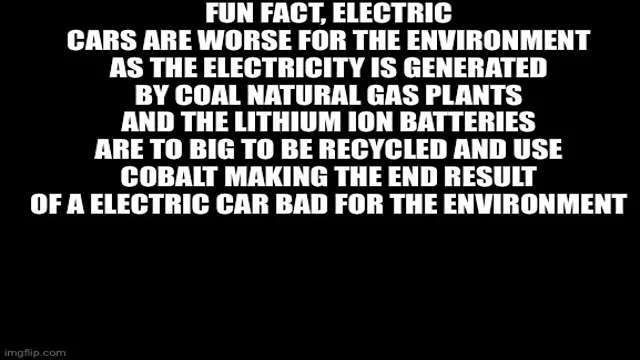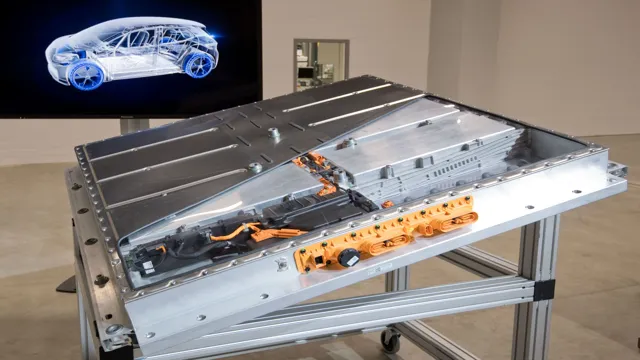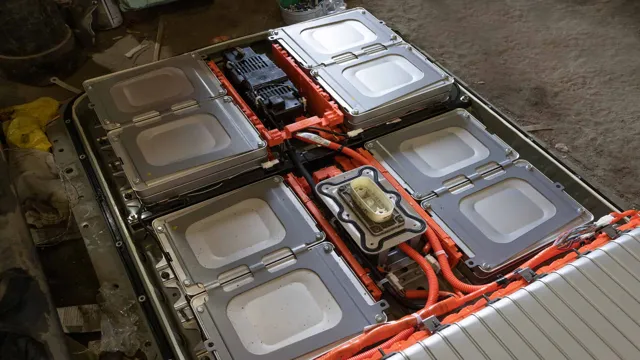Unveiling the Truth: Are Electric Car Batteries Really Worse for the Environment?
Electric cars have surged in popularity over the last decade as the world becomes more aware of the impact of carbon emissions on the environment. Many of us have embraced the idea that driving an electric car is better for the planet because they produce far less pollution. But have we considered the environmental impact of the batteries that power these electric vehicles? The lithium-ion batteries used in these cars offer a wide range of benefits, but they also come with their own set of concerns.
The production, transportation, and disposal of electric car batteries have a significant impact on the environment, but there are ways in which we can mitigate this impact. In this blog post, we’ll look at the different facets of the environmental impact of electric car batteries and what we can do to reduce this impact.
Understanding Battery Production
It’s no secret that electric car batteries have been touted as the way of the future, but recent research suggests that they may not be as environmentally friendly as previously thought. While electric cars produce zero emissions on the road, the production of their batteries requires a significant amount of energy and resources, mainly coming from the extraction of minerals like nickel, cobalt, and lithium. In addition, the process of manufacturing these batteries generates carbon dioxide emissions.
However, it’s important to note that the production of traditional gasoline-powered vehicles also has a high environmental impact. Therefore, it’s crucial to find sustainable solutions for battery production, such as using recycled materials and renewable energy sources like solar and wind power. Despite the current challenges, the potential benefits of electric cars and their batteries cannot be ignored, highlighting the need for continued research and development in the field.
The Raw Materials
When it comes to understanding battery production, it’s important to start with the raw materials. The primary components of a battery include cathodes, anodes, electrolytes, and separators. Cathodes and anodes are typically made of metals and metal oxides, while electrolytes are made up of salts and solvents.
The separators are usually made of polymer materials, and they prevent the cathode and anode from touching each other, which could cause a short circuit. These raw materials are carefully chosen and precisely combined to create the various types of batteries we use in our daily lives. From powering our smartphones to electric cars, batteries have become an integral part of our modern society.
As technology advances, researchers are constantly looking for new and better raw materials to improve battery performance and efficiency. The demand for better batteries is sure to only grow, making the understanding of battery production more important than ever.
The Manufacturing Process
Battery production is a fascinating and complex process that involves careful attention to detail at every stage. The process varies depending on the type of battery being produced, but in general, it involves several key steps. One of the most important steps is the manufacture of the electrodes, which are the heart of the battery.
This involves the careful application of active materials, such as graphite and lithium cobalt oxide, onto a conductive substrate, such as copper or aluminum foil. These electrodes are then assembled with a separator and electrolyte to form a complete battery cell. Quality control is critical at every stage of the process to ensure that the final product meets the high standards required for safety and reliability.
As demand for rechargeable batteries continues to grow, manufacturers are constantly looking for ways to optimize their production processes to increase efficiency, reduce waste, and minimize environmental impacts. Overall, battery production is a fascinating and complex field that requires a deep understanding of chemistry, materials science, and engineering to be successful.
Life Cycle Analysis of Battery Usage
The growing popularity of electric cars has led to a surge in the production of electric car batteries. However, studies have shown that the manufacturing process of these batteries is worse for the environment than the manufacturing of traditional gasoline-powered car batteries. This is due to the fact that electric car batteries require a large amount of raw materials, such as lithium and cobalt, which are primarily mined through destructive extraction methods.
Additionally, the energy required to manufacture these batteries, along with the energy needed to power the electric cars, has a significant carbon footprint. However, it’s important to consider the entire life cycle of the battery, including its disposal and recycling, which can also have negative environmental impacts if not handled properly. As electric cars become more common, it’s important to continue to seek out and implement more sustainable battery manufacturing and disposal methods to minimize their impact on the environment.
Carbon Emissions from Production to Disposal
Battery usage has become more and more prevalent in our society, with various industries relying on them for power supply. However, it’s essential to recognize the significant environmental impact this technology has from production to disposal. Life cycle analysis of batteries highlights the carbon emissions during production stages, including material extraction, manufacturing, transportation, and assembly.
Additionally, using and disposing of batteries has environmental consequences. While the production stage accounts for about a quarter of the carbon footprint, the usage and disposal stages contribute significantly to the environmental impact, with disposal leading to toxic waste. As we continue to rely on battery technology, it’s essential to find ways to reduce the carbon footprint by using renewable energy in the manufacturing process and responsibly handling battery disposal.
We must take environmentally-friendly steps to ensure a cleaner and safer future for our planet.
Comparison with Gasoline Car Emissions
When it comes to comparing the emissions of electric cars with their gasoline counterparts, it’s important to consider the entire life cycle of the battery. Yes, electric cars are emission-free on the road, but the production of the battery and the electricity used to power the vehicle can create emissions. However, when looking at the bigger picture, electric cars still come out ahead.
A recent study found that over their entire lifetime, electric cars emit 50% less greenhouse gases than gasoline cars. This is due to the fact that electric cars become cleaner as the grid that powers them becomes cleaner. As more renewable energy sources are added to the grid, the emissions from charging an electric car decrease, while gasoline cars will always emit harmful pollutants.
So, while there may be some emissions associated with the production and use of electric car batteries, the overall impact on the environment is significantly less than that of gasoline cars.
Battery Recycling and Reuse
Battery recycling and reuse are essential components of a sustainable future. Assessing the life cycle of batteries can help us understand their environmental impact and the importance of proper disposal. A proper life cycle analysis includes all stages of battery use, including raw material extraction, manufacturing, transportation, use, and end-of-life disposal.
By analyzing these stages, we can identify areas where improvements can be made, such as using more sustainable raw materials, reducing transportation emissions, and implementing safe disposal practices. With proper recycling and reuse, the life cycle of batteries can be extended, reducing waste and conserving valuable resources. Let’s imagine that batteries are like a reusable shopping bag.
If we use them wisely, they can have a positive impact on the environment and reduce the amount of waste we produce. However, if we choose to dispose of them carelessly, they can become a hazard to the environment. Therefore, it’s crucial to consider the entire life cycle of batteries to contribute to a more sustainable future.
Potential Solutions for Reducing Environmental Impact
Electric car batteries are often touted as environmentally friendly, but recent research suggests that their production may actually be worse for the environment than that of conventional gasoline cars. However, there are several potential solutions to reduce the impact of electric car batteries on the environment. One option is to invest in research and development to find more sustainable production methods for battery materials, such as lithium.
Another solution is to encourage the recycling of old battery materials, which can help to reduce waste and recover valuable resources. Additionally, the use of renewable energy sources, such as solar and wind power, to charge electric car batteries can further reduce their environmental impact. These solutions may not completely solve the problem, but they are important steps towards a more sustainable and environmentally friendly future.
Improvements in Battery Technology
Improvements in battery technology have the potential to greatly reduce the environmental impact of various industries. One of the biggest challenges in creating more sustainable energy solutions is the need for reliable energy storage. With advancements in battery technology, we can improve the efficiency and reliability of renewable energy sources, such as solar and wind power, and reduce our reliance on fossil fuels.
Additionally, more sophisticated batteries can enhance the performance of electric vehicles, making them an even more attractive option for reducing emissions and combatting climate change. While there are still challenges to overcome, such as improving the longevity and recyclability of batteries, it is clear that advancements in this field have the potential to make a significant impact on the health of our planet and our communities.
Sustainable Disposal Methods
When it comes to reducing the environmental impact of waste disposal, there are several potential solutions that can help. Recycling is perhaps the most well-known of these methods, and it involves reusing materials like paper, plastic, and metal so that they don’t end up in a landfill. Another important strategy is composting, which involves breaking down organic waste like food scraps and yard waste into nutrient-rich soil.
This can not only help reduce the amount of waste that goes to landfills but also improve soil quality for farming and gardening. Other potential solutions include incineration, which burns waste at high temperatures to reduce its volume and generate energy, and waste-to-energy technologies, which use waste as a fuel source to generate electricity. Ultimately, the key to reducing the environmental impact of waste disposal is to adopt sustainable practices that minimize waste and maximize resource recovery.
By doing so, we can help protect the planet and create a more sustainable future for ourselves and generations to come.
Conclusion: Verdict on Electric Car Batteries
Despite the many benefits of electric cars, it’s clear that their batteries have a negative impact on the environment. As ironic as it may sound, as we strive to transition to more climate-friendly transportation options, we need to also consider the environmental consequences of the technology powering these vehicles. Until we find a truly sustainable and eco-friendly solution, it seems that our efforts towards reducing carbon emissions are simply shifting the problem elsewhere.
It’s a stark reminder that every technological advancement comes with its own set of trade-offs, and we must approach progress with a critical eye.”
FAQs
Why are electric car batteries worse for the environment?
Electric car batteries require the extraction and processing of rare minerals, which can contribute to environmental damage and pollution. Additionally, the disposal of electric car batteries can also pose a threat to the environment if not properly handled.
Are traditional gasoline cars better for the environment than electric cars?
While gasoline cars rely on fossil fuels that emit greenhouse gases into the atmosphere, electric cars can also have negative environmental impacts due to the manufacturing and disposal processes of their batteries. Ultimately, the environmental impact of each type of vehicle depends on the specific circumstances and how they are used.
How can the environmentally harmful effects of electric car batteries be mitigated?
One way to reduce the environmental impact of electric car batteries is to invest in research and development of new battery technologies that use more sustainable materials and production processes. Additionally, properly recycling and disposing of used batteries can also help to reduce their impact.
Are there any incentives for recycling electric car batteries?
Yes, some governments and car manufacturers offer incentives and programs for recycling electric car batteries to promote their proper disposal and minimize their environmental impact. These programs may include financial incentives or take-back programs for used batteries.






